Scaling Up Cell Culture - Lecture 6
1/76
There's no tags or description
Looks like no tags are added yet.
Name | Mastery | Learn | Test | Matching | Spaced |
|---|
No study sessions yet.
77 Terms
cell culture basics:
sterilization & culture conditions
culture flasks/surfaces
media & supplements
passaging
stability in culture
freezing
Answer: “okay”
okay
what temperatures are incubators kept at? (in degrees Celsius)
37
how do incubators regulate air control?
typically ___% O2, can be varied as desired
___% CO2 ALWAYS — exchange with sodium bicarbonate in medium impacts pH
Maintains optimal pH: ____
Humidity control: >___%
20, 5, 7.3, 95%
how does the % of CO2 affect the pH of the medium?
exchange with sodium bicarbonate in medium impacts pH
What are 3 ways to maintain sterility in culture?
aseptic technique, laminar flow hoods, sterility of all materials

List at least 3 ways to sterilize materials. (Mark it correct if you get it right)
autoclave
ethylene oxide gas
ethanol/isopropyl alcohol
UV radiation
Fluid — autoclave or filtration
Cell Culture Flasks for Adherent Cells:
Disposable plastic ________ most common
96- to 6- well plates, petri dishes, flasks
Tissue culture treated:
Exposing a polystyrene microplate to a _______ ____ in order to modify the hydrophobic plastic surface to make it more ________. The resulting surface carries a net _______ charge due to the presence of _______-containing functional groups such as ________ and ________. In general, this will lead to (increased/decreased) cell attachment.
Matrix coating:
Poly-L-lysine
Collagen or gelatin
Matrigel
ECM components
polystyrene, plasma gas, hydrophilic, negative, oxygen, hydroxyl, carboxyl, increased
culture flasks/surfaces for non-adherent cells:
96- to 6- well plates, petri dishes, flasks, spinner flasks
Non-adherent surfaces
Non-adherent cells can grow as:
_____ _______
_________
Spheroid initiation
spontaneous
co-culture
surface treated beads
single cells, spheroids
what is the most popular media?
(Dulbecco’s Minimum Essential Media)
DMEM
What are common supplements to media?
serum, antibiotics
Physiochemical properties of media:
pH
~____ ideal range
________ red
Bicarbonate, HEPES, and CO2 — osmolarity and ____ control
(HEPES is commonly used as a biological buffering agent in biochemical research that helps maintain a stable pH in aqueous solutions.)
Oxygen and _____ _______
Temperature
7.4, phenol, pH, free radicals
Cells reach ______________ as they grow, i.e. they begin to cover the flask or compete with each other for nutrients
confluency
For _________ cells, confluency is defined by coverage of the bottom of the flask, e.g. 80% confluent means cells cover ~80% of the flask
adherent
True or false: the degree of confluency a specific cell will “like” is the same for all cell types and passages
false
__________ cell lines tend to permit higher confluency
continuous
cells are removed from a flask and split into more than one other flask to provide room for further proliferation.
(The ratio of dilution can vary and depend on desired cell number, time, and cell type (e.g. 1:1, 1:5, 1:20))
passaging
how are adherent cell usually removed from their attached surface?
trypsinization
Factors that affect cell stability in culture:
________ drift due to genetic instability
__________ and extinction of cell line due to cell “lifespan”
Transformation of growth characteristics and/or acquisition of malignancy-associated properties
Phenotypic instability due to selection and dedifferentiation
How often and how the cells are split (confluency and split ratios)
Contamination
genetic, senescence
Basic Primary Cell Isolation Method (General):
Mince or ____ the isolated piece of tissue into 2-4 millimeter pieces with sterile scissors or scalpel.
Add the tissue pieces to the appropriate _______ or balanced salt solution
on ice and wash 2-3 times.Add appropriate amount of ________ and incubate at optimum
temperature (usually 37°C) for appropriate time, mixing intermittently.Gently disperse the cells by _________.
_______ the cell suspension through fine mesh.
Allow the cells to settle and _____ excess liquid containing enzymes.
Wash and repeat 2-3 times.___________ cells in appropriate medium or buffer.
_______ cell yield and viability.
______ cells for culture, if required
cut, buffer, enzymes, pipetting, filter, decant, resuspend, quantify, seed
Enzymes
highly dependent on tissue type — ECM surrounding cells can be highly variable
Commonly used: collagenase, hyaluronidase, elastase, papain, trypsin (from least to most digestive)
Answer: “okay”
okay
Mechanical disruption:
Agitation to release cells from ECM
Balance between _____ and ________
yield, viability
Cell sorting:
cell __________ (morphology, size, charge, etc.)
gradient
MACS — ________ ________ cell sorting
FACS — _______ _________ cell sorting
Positive selection — tag target cell
Indirect selection — tag non-target cells
Purity depends on sorting method and marker specificity
characteristics, magnetic activated, fluorescence activated
what matters when sorting cells by characteristics?
morphology, size, charge
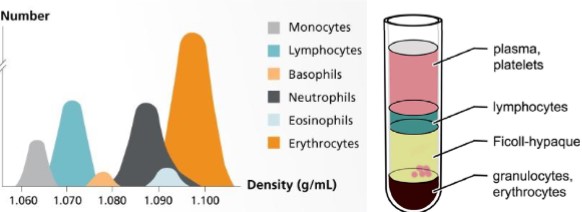
cell sorting — gradient
layer sugar solutions (ficoll) or colloidal silica (percoll) of varying ________ to generate gradients
densities
Antibody-Based Sorting
Sorting of desired cell by targeting a specific ______ to a specific marker (_______) expressed only on that desired cell surface
Antibody — antigen specificity
Examples:
Magnetic activated cell sorting (MACS)
Fluorescence activated cell sorting (FACS)
antibody, antigen
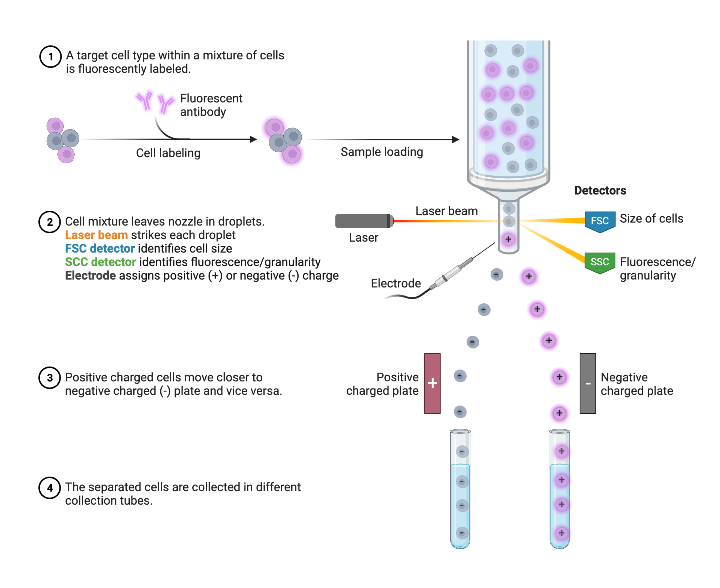
What cell sorting technique is being described?
Cells are fluorescently labeled using antibodies against cell-specific markers
Records fluorescent signals from individual cells (~500 cells/sec)
Physical separation
Quantification of cell type/number/etc.
Can sort a heterogeneous mixture of biological cells — one cell at a time
fluorescence activated cell sorting (FACS)
Advantages of FACS
High _______(95%-99.999%) of the target population
Cells express (low/high) density of surface markers (since fluorescence, do not need a lot of antibodies bound to detect)
Subclass separations — _________ staining
_______ staining (e.g. of DNA or internal antigens) sorting
purity, low, multicolor, internal

MACS
Antibodies tethered to __________ __________
Positive (magnetic label) or negative (no label) fractions
Can remove magnetic label but not perfect
Good purity (___-___%) depending on number of separation and overall cell contaminants
paramagnetic microbeads, 70-95
true or false: you can use combinations of cell sorting methods
true
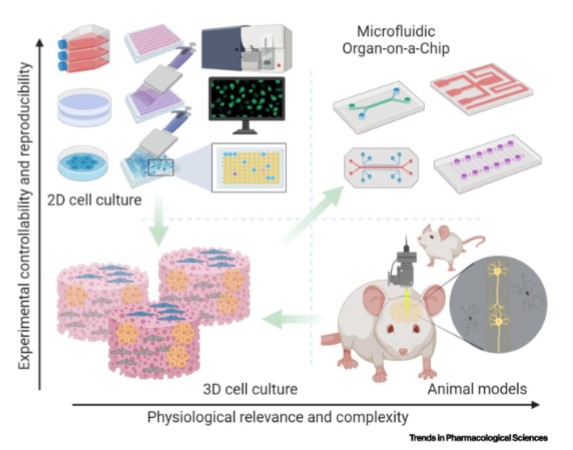
2D cell culture:
(Low/high) reproducibility and experimental controllability
Too ________ to represent complex physiological structure
Grow on the glass or ________ surface
high, simple, polystyrene
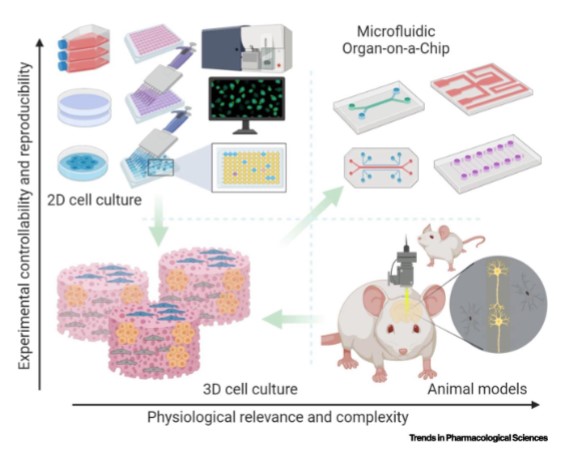
Animal Models:
Require animal sacrifice
(Low/high) efficiency on time and cost
low
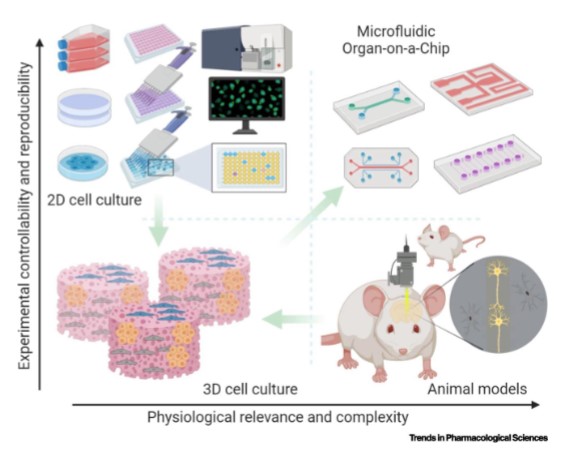
3D culture models:
Promote levels of cell ________
Recapitulate the tissue-tissue interface
Spatiotemporal concentration gradients
Mechanical microenvironment of the tissue
differentiation
what is a promising interdisciplinary technique emulating in vivo physiology and pathology?
organ on chips
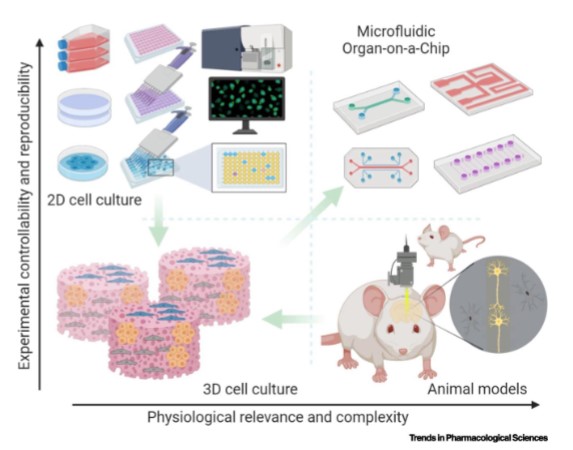
Organ chips can be used for:
drug __________
in ______ disease _________
precision medicine
screening, vitro, modeling
What parameters does organ-on-a-chip mimic?
Example: biochemical molecules
Example: blood pressure, lung pressure, and bone pressure)
concentration gradient, mechanical stress, cell patterning
Microfabrication techniques for organ on a chip
Build organ on chips or other microfluidic platform
Molding — using thermoplastic _______ to create mold
Micromachining — by _______ (subtractive method), or _________ (additive method)
____________ or soft lithography
A process that involves the transfer of a pattern onto a substrate by selective exposure to light
3D printing
polymers, etching, deposition, photolithography
Why Use Microfluidic:
Sample savings — nL of enzyme, not mL
Faster analyses — can heat, cool small volumes quickly
Integration — combine lots of steps onto a single device
Novel physics — diffusion, surface tension, and surface effects dominate
(can lead to faster reactions)
Answer: “okay”
okay
a 3D structure grown from stem cells, or organ-specific cells that self-organizes through cell sorting and spatially restricted lineage commitment.
organoids
4 sources of organoids:
iPSCs, ESCs, MSCs, organ-specific cell types
How are organoids different than OoAC?
Organoids have key _______ and physiological ______ of the organ for both therapy and research
Ooac: mimic for physiological conditions. Not for therapy purposes, mainly for research
function, structure
what are cell densities in a human tissue?
1-3×109/mL
how many cells in an average human (70 L)?
1014
how many cells in a typical organ (100-500 mL)?
1-15×1011
how many cells in a “functional” subunit (100 microns cubed)?
500-1000
how many cells are needed for TE strategies?
(Cell culture densities ~107/mL)
~107-1010
There are limits to the # of primary cells one can produce. One cells can only undergo 30-50 doublings (1010-1015 cells). What is this limit called?
(This limit is generally not the problem in scaling up)
Hayflick limit
what 2 factors determine growth potential?
donor age, cell type
What are typical cell doubling times?
Hematopoietic progenitors = __-__ hrs
Adult chondrocytes = __-__ hrs
Adult human cardiomyocytes = cannot be cultured
11-12, 24-28
Choose one: cell proliferation (increases/decreases) with donor age.
decreases
Scaling up Design Challenges: oxygen delivery
Cell must be exposed to physiologic [O2] (___ mM)
Oxygen must be provided at the same rate _____
0.2, consumed
true or false: oxygen uptake rate is the same for all cell types
false
Problems with oxygen delivery:
O2 has a (low/high) solubility & excessive flow rates are required to deliver oxygen to high cell densities
Large differences in [O2] can occur at inlet and outlet and this can lead to microenvironments that are very different
low
Specific Oxygen-Uptake Measurements: Nonadherent cells
Place a known number of viable cells in a closed volume of medium saturated with O2
An oxygen probe measures O2 tension over time.
Value is normalized to cell number to obtain rate of O2 uptake per cell
Answer: “okay”
okay
Specific Oxygen-Uptake Measurements: Adherent cells
Cells are plated on a 6-well plate
Well inserts hermetically seal off culture volume
Oxygen probe measure change in [O2] and this value is normalized to # of cells counted after O2 is consumed.
Answer: “okay”
okay
Growth Factor Delivery and Removal
GFs diffuse much (slower/faster) than O2 and other nutrients
Their concentrations are very, very, (low/high) (nM range).
Complicating matters: cell produce their own GFs!
slower, low
Why are concentration levels and distribution of nutrients easier to control?
Nutrients are (less/more) soluble than O2 so their concentration can be higher
Nutrients are (smaller/bigger) than GFs, so they have (slower/faster) diffusion times.
more, smaller, faster
cells can be stored for an extended period of time in liquid nitrogen at -196 degrees Celsius
cryopreservation
Cryopreservation permits:
_______ of early passage cells (before senescence)
prevention of _______ drift
prevention of ________
prevention of ________ drift (spontaneous chromosomal alterations)
Cell _______ to replace contaminated cells
storage, phenotypic, transformation, genotypic, source
cryopreservation
Cells are cooled at a specific rate in a solution containing _________ to inhibit the intracellular formation of ____ _______ and cell _______
cryoprotectant, ice crystals, death
true or false: cooling rate for cryopreservation is critical
true

Cryopreservation: slow vs. fast cooling rates
slow cooling rate — _______ extracellular solution ________ cells
leads to visible shrinkage
ice forms — solutes accumulate in unfrozen H2O
fast cooling rates — intracellular H2O cannot diffuse across cell membrane before ice nucleation. Large intracellular ice formation ______ cells.
hypertonic, dehydrates, injures
when are cells typically frozen for cryopreservation?
at 5th doubling
what is the most critical parameter of cryopreservation
reducing intracellular ice crystal formation

How to reduce intracellular ice crystal formation during cryopreservation?
Freeze (slowly/quickly)
(hydrophobic/hydrophilic) cryoprotectant
store at (lowest/highest) temperature possible
thaw as (slowly/quickly) as possible
slowly, hydrophilic, lowest, quickly
what is the most populat cryopreotectant?
DMSO
what temperature to store frozen cells at?
-80 degrees Celsius or in liquid nitrogen (-180 degrees Celsius)
what are 2 ways to reduce contamination?
sterile techniques and antibiotics
list 4 types of contaminants:
bacteria, yeast, fungus, mycoplasma
how can you tell if your cells are contaminated?
media cloudiness, change in pH, change in cell population
what is the easiest type of contamination to detect?
bacterial
clues of bacterial contamination:
media without phenol red may turn ______
media may become ______
media may have a distinct ____
yellow, turbid, odor
true or false: antibiotics can cure a mycoplasma infection
(mycoplasma are bacteria lol)
true
Yeast contamination:
cultures contaminated with yeasts become _______
there is very little change in the pH of the cultures contaminated by yeasts until the contamination by yeasts until the contamination becomes heavy, at which stage the pH usually (decreases/increases)
Under microscopy, yeasts appear as individual ovoid or _________ cells, which may bud off smaller cells
turbid, increases, spherical
true or false: often the color of the medium often changes with fungal contamination
false
true or false: when you have contamination, the best option is to discard your contaminated culture
true
Different sensors used in a bioreactor:
pH sensors
dissolved oxygen (DO) sensors
carbon dioxide (CO2) sensors
temperature sensors
biomass sensors (cell growth and viability)
glucose and lactate sensors
optical density (OD) sensors (cell density)
pressure sensors
Answer: “okay”
okay
reasons for cell death in bioreactor:
bubble bursting
nutrient depletion
toxin accumulation
hydrodynamic forces
high and low dissolved oxygen
sub-optimal temperature
pH variations
Answer: “okay”
okay